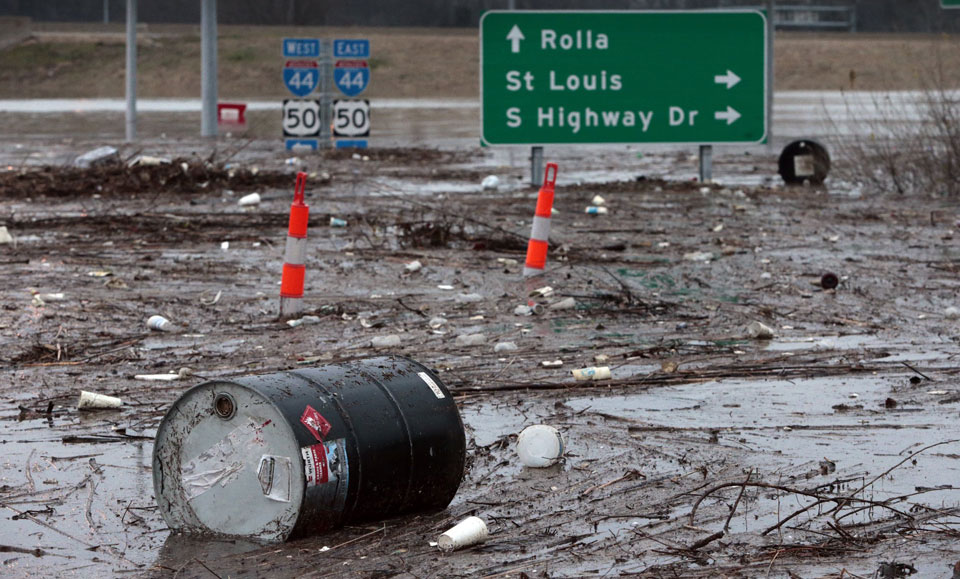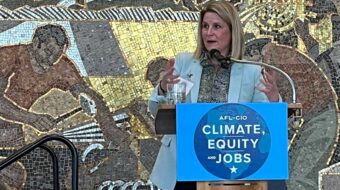
Late spring and early summer this year were uncharacteristically wet for the Midwest, causing destructive flooding, particularly along the Mississippi. The Mississippi is not alone, as other tributaries such as the Arkansas River and Ohio River also experienced record floods. Heavy rains were not the only worry for many across the Midwest, as tornado season hardly wrapped up by the end of June, leaving more than 200 tornados to date. While larger rivers like the Mississippi, Arkansas, and Ohio get all the attention, we cannot forget about small tributaries like the Vermillion, Illinois, Des Plaines, and Kankakee rivers that all equally flood due to heavy rain. Travelers down Illinois I-55 could often see these rivers rise to just a few feet below many bridges.
Weak levees and rising waters along the banks do more than get everything wet: The water swallows up anything not firmly rooted to the ground. From trash and lawn decorations to hazardous chemicals—everything was dragged downstream by the cresting rivers. Long-lasting floods have broken barriers in the Quad Cities, a cluster of cities on the Illinois-Iowa border across the Mississippi River. Similarly, levees in Dardanelle, Arkansas, broke after prolonged rain and high waters.
There is no shortage of examples of levees breaking, roads flooding, cars being abandoned, and houses filling with water. Major cities are not safe either, as St. Louis and Chicago have also experienced high waters, one from the Mississippi, the other from Lake Michigan. Flooding was so severe that Illinois deployed 400 of its National Guard members to help with relief efforts.
To add greater concern, a year ago concerns were raised by reports of coal ash along the Vermillion River near the Illinois-Indiana border possibly contaminating the water. That stretch of the Vermillion runs into the Wabash River, which then leads to the Ohio and eventually to the Mississippi. While not experiencing such heavy rainfall as the western portion of the state, rising levels could have made the disaster they warned about a reality.
Rising rivers and contamination have not been the only concern. These same heavy rains also delayed planting season for Midwestern farmers. Flooded fields prevented many from planting into late May and early June, something typically done by mid-May. A USDA report shows Illinois alone had only planted 11% of its corn by May 12 compared with more than 80% planted in that same time frame from 2014-18. Soybeans are in a similar situation: 4% planted by May 12 this year, while more than 35% was planted from 2014-18. It’s the same for Arkansas rice farmers. It is so bad that the effects can be seen from space. It is not just farmers, but commerce and transportation as well.
Heavy rains have swept away and ruined many people’s livelihoods and savings. However, more than what is swept away, it is also about what is left behind. Water that reaches Central Illinois and further south is not what anyone would consider sanitary. Industrial and urban waste from Chicago, Milwaukee, and Minneapolis-St. Paul all makes its way south. This is nothing new, ever since Chicago reversed its river in 1900.
Initially emptying into Lake Michigan, Chicago’s water became undrinkable and a solution had to be made. Instead of refusing to dump waste into water, mostly because it was cheap to do so, the city decided to reverse the flow, sending all the waste south. An injunction filed by St. Louis made it to the Supreme Court but the court ruled in Chicago’s favor, allowing for the reversal to proceed. In the coming years, the relatively clear water down south became gray, sloppy, smelly, and almost undrinkable, not to mention that it caused large swaths of erosion.
Few are unaware of this animosity that, opposite of the Mississippi, flows northward. If you bring up the topic, or just listen in on casual conversation, with anyone south of Illinois’s section of I-80, the sentiment is constant: Those northerners ruin everything. Chicago’s choice to reverse their river, that now eventually flows into the Mississippi, created a tension that has never fully dissipated. So much so, that an Illinois bill is currently making its rounds to separate Chicago from the rest of the state.
It isn’t only industrial and urban waste that contaminates waterways. Agricultural waste seeps into the water as well. Fertilizer, pesticides, and animal waste all find their way in from rain run-off, legal and illegal dumping, and hazardous floods. Two of the largest contributors, Iowa and Illinois, compound the industrial waste as it hits St. Louis and the rest of Missouri. This creates a situation where, when flooding occurs, St. Louis and other areas are submerged in some of most contaminated waters in the nation.
St. Louis is not innocent either. Like all metropolitan areas, its waste flows into the Mississippi and other tributaries, not to mention occasional watermain or sewage breaks. When the Mississippi meets the Ohio at the southern tip of Illinois, more contaminants are added directly from Ohio, West Virginia, Kentucky, and Indiana. The conditions by which the rivers are polluted are largely the same. Replace Minneapolis with Columbus, Chicago with Cincinnati, St. Louis with Louisville, and all the rural areas in between.
The situation does not improve the farther south you go. The Mississippi flows by Memphis, Tenn., on its way to the Arkansas tributary as it picks up Tulsa, Okla., and Little Rock, Ark. All were affected by this year’s record rain fall and flooding, and that is to say nothing about the varying levels of environmental protections state to state. Carrying its now deadly waste through Baton Rouge and New Orleans, it creates what is known as a dead zone the size of New Hampshire around New Orleans in the Gulf of Mexico which has seriously affected local fishing.
While the water pollution in the Mississippi is a constant, current weather patterns have exacerbated the issue. There are those who claim that this year’s heavy rainfall, largely attributed to El Niño, is a part of climate change, and they are not unfounded in their belief. The Midwest was to expect a drier season, though clearly that has not been the case thus far.
Where ultimate responsibility rests on this issue is up for debate, but what is for certain is that continually blaming others will not solve the issue before it turns into crisis. The vast majority of residents in any of the states mentioned have relatively little to do with this trickle-down issue. The time for southerners blaming Yankees, Missourians blaming Illinoisans, and Illinoisans blaming Chicagoans is over.

Stronger and stricter environmental regulations are a way to combat waste contamination, but they will only go so far. Overproduction and cash crop farming inherently contribute to contamination as each requires greater amounts of resources to produce for marginal monetary gains. This is true particularly in agriculture, where we already grow enough food to feed 10 billion people and where 30-40% of food is wasted. Additionally, corn in Illinois and Iowa requires nutrient-heavy soil that has since largely deteriorated from over-farming and must be reintroduced to the soil as fertilizers, creating waste runoff. Further, this corn is mostly used for livestock and alcohol for fuel, which is more profitable than corn grown for normal human consumption, and creates its own environmental issues, particularly in relation to water in the form of animal waste.
Industrial pollution is hardly a minor factor. In Chicago alone, there is no shortage of stories about workers dumping into the river or general urban waste, as well as Tyson dumping in Missouri, or toxins from Iowa. While these are just some examples from the Midwest, one could find similar stories as far east as Pennsylvania, west as Colorado, or south as Mississippi.
No one state is immune from blame, and no one state can take all the blame. One bold piece of legislation, the Green New Deal, looks to address many of these issues. However, the introduced bill is only a resolution for Congress to create a New Deal-like program that will require subsequent bills and acts to fulfill its initial promises. Given that we only have 11 years to fully address our impending climate crisis, and that the speed at which the U.S. government moves is too slow regardless of who is in office, that may be too little too late.
Immediate solutions are needed, such as organizing for mutual aid and support, local and regional community planning, and preventive maintenance on critical infrastructure. Further radical solutions for a sustainable future, like a six-hour day with no cut in pay, a more relationally planned economy, a focus on ecological conservation and protection, and a system which places the people’s well-being and voice over profits is critically needed. A system in which the people, the workers, are in control of the state—rather than the same individuals causing this crisis—is the only way to avoid ecological collapse.
In creating such a system, we cannot punish the north to save the south, nor can we ignore the issues caused by the north to continually punish the people living in the south. Rather it is time to push aside old animosities and understand we must come together. We are all connected in this large Mississippi watershed and must recognize that we share more in common than we do apart. Solidarity from Chicago to St. Louis to New Orleans is the only way we will move forward to address these issues before they become a yearly and irreversible occurrence.












Comments